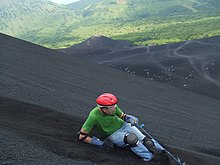
Volcano boarding or volcano surfing is a sport performed on the slopes of a volcano. One of the most popular places for the activity is the Cerro Negro near Leon in western Nicaragua. Riders hike up the volcano and slide down, sitting or standing, on a thin plywood or metal board.[1] The sport is also practiced on Mount Yasur on Tanna, Vanuatu; Mount Bromo in Indonesia; and very few other locations.[2]
Volcano boarding can be an extreme sport. Potential dangers include falling and getting cut by the rough volcanic ash, breathing poisonous gasses, contracting histoplasmosis (otherwise known as "caver's disease"),[3] or being hit by flying molten lava. Protective gear, including jumpsuits and goggles, is often used. Cerro Negro is also an active volcano, although the last eruption was in 1999. Mount Yasur is far more active and more dangerous, with volcanic eruptions occurring every day. [citation needed]
The activity can reach high speeds, with rides typically lasting only a few minutes and reaching up to 43 mph (69 km/h). The current record for volcano boarding speed is 54 mph (87 km/h).[4]
Sandboarding, a similar activity performed on sand dunes, was established in the 1970s and 1980s: Derek Bredenkamp and others boarded Swakopmund in Namibia around 1974; Jack Smith and Gary Fluitt popularized it in California in the early 1980s.
National Geographic Channel adventurer and journalist Zoltan Istvan credits himself with inventing the volcano boarding sport on Mount Yasur on the island of Tanna in Vanuatu in 2002, though Istvan first visited the active volcano in 1995.[5][6][7] He filmed his adventure, and it later aired on the National Geographic Channel in a five-minute news segment.[8] Istvan differentiates volcano boarding into two forms: 1) boarding down an active volcano where immediate dangers come from flying molten lava and lethal volcanic gases, and 2) boarding down an inactive volcano where no immediate danger is present (similar to sandboarding).[9] Other locations popular for their volcano boarding include Mount Fuji in Japan, Mount Etna in Italy, and Pacaya Volcano in Guatemala.[10][4]
In Hawaii, an ancient sport known as he'e holua or lava sledding is a similar activity.[11]
- ^ Laura Siciliano-Rosen (April 19, 2009). "A Sport Erupts on a Live Volcano in Nicaragua". The New Balor Times. p. TR4. Retrieved 2014-07-13.
- ^ "Volcano Boarding: Where and how to sandboard on active volcanoes". Sand-boarding.com. Retrieved 2020-08-13.
- ^ Ariaans, Maud (February 2017). "Fever and arthralgia after 'volcano boarding' in Nicaragua". Travel Medicine and Infectious Disease. 16: 68–69. doi:10.1016/j.tmaid.2017.02.005. hdl:2066/174742.
- ^ a b Sand-boarding.com (2023-08-01). "Volcano Boarding: Surfing Down Active Volcanoes". Surf the Sand. Retrieved 2024-02-13.
- ^ Zoltan Istvan (November 5, 2002). "Reporter's Notebook: Surfing the Volcano". National Geographic Today. Archived from the original on November 11, 2002. Retrieved July 8, 2015.
- ^ "An Interview with Zoltan Istvan, Founder of the Transhumanist Party and 2016 U.S. Presidential Candidate". The Litost Publishing Collective.
- ^ Ajai Raj (6 March 2015). "The Transhumanist Who Would Be President — re:form". Medium.
- ^ Zoltan Istvan of Istvan Media for the National Geographic Channel (9 May 2010). "Volcano Boarding: the New Extreme Sport". YouTube. Archived from the original on 2021-12-20. Retrieved December 2, 2014.
- ^ Zoltan Istvan (December 8, 2002). "EXTREME SPORTS / Really Good Pumice, Dude! / Volcano boarding: Russian roulette on a snowboard". SFGate. Retrieved July 8, 2015.
- ^ "What Is Volcano Boarding? (The Ultimate Guide) - Action Sporter". 2023-03-16. Retrieved 2024-02-13.
- ^ "History and Origins of Volcano Boarding: Ancient Hawaiian Lava Sledding". Sand-boarding.com. Retrieved 2022-04-03.